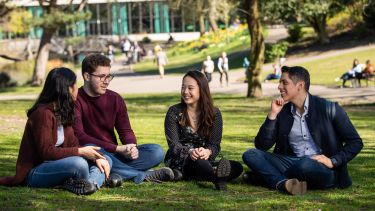I enjoy the broad spectrum of design skills and the atmosphere of studio work.

Tell us a little about yourself from before your University days
I finished high school in Bulgaria and had always enjoyed arts and science but was a little unsure about pursuing a career in architecture. My hobbies include drawing, painting, and handmade crafts like embroidery, and sculpting.
After researching the course and modules, I was inspired to pursue BA in Architecture the School of Architecture and Landscape - a school with a strong social agenda. I have since really enjoyed the broad spectrum of skills the course has taught me within the design sphere such as digital production, editing, research, critical thinking, applied technology, and presenting my ideas.
You also studied your BA at the Sheffield School of Architecture. What made you come back?
After completing my BA Architecture degree at Sheffield, I got a job as an architectural assistant and found my education was perfectly suited to what was expected of a Part 1 graduate.
I was enjoying working in a practice but was also eager to continue my education so I chose to return on the collaborative practice course. The course is one of the few alternative options to complete Part 2 in the UK and allowed me to continue working in practice for the first year of the MArch course before joining full-time in the second year.
What is working on a Live Project like?
Working on a Live Project is very exciting and challenging and resembles working in a practice led by a group of students. The experience teaches you about the different roles and responsibilities of the architect such as managing time, client's budget, and expectations. Live Projects take place at the beginning of the first semester and are a great opportunity to get to know coursemates and make friends while also expanding your skillset and knowledge.
What module have you enjoyed most so far?
The design module is really enjoyable because developing a project involves a combination of background reading and research, prototyping by model making, and drawing. It gives you a well-rounded experience and skillset. Each project allows you to explore different ideas and focus on specific research strands.
What do you enjoy about the course?
I really enjoy the broad spectrum of skills the course teaches within the design sphere such as digital production, editing, research, critical thinking, applied technology, and communicating ideas. I appreciate the group social atmosphere of studio work and occasional group projects.
What do you do outside of study?
I train at a CrossFit gym and like to unwind by taking walks in nature or pursuing my craft hobbies.
What do you like about the wider University and about Sheffield as city?
I like the walkability of the university campus and the city centre of Sheffield. I love that Sheffield is so close to the Peak District - just a bus ride away. Sheffield is home to a lot of international restaurants so there is always a new cuisine to explore. My top three recommendations are Pocha Korean Restaurant on Division Street, DOMO Restaurant in Kelham Island and Yama Sushi on London Road!
Can you share an example of your work?
Temporary Makers Hub, Sunderland
The project recognises and celebrates the unique heritage of Sunderland as a community of makers by providing a hub for crafts and technology. The proposal investigates how architecture can offer a temporary flexible provision for specialist artist and makers’ spaces while incorporating values of sustainability, cultural continuation, and a sense of place and community.
Flexibility and the capacity to expand are incorporated in the design by the use of the grid to create 6m wide studios in a typical section, linked to a circulation space, while a flexible hall functions as an extension to the studios by providing spaces for larger events and exhibitions.
The studios are capable of being subdivided and connected both horizontally and vertically. Aesthetically, a limited palette of materials is employed and exposed wherever possible. The project development took me on a journey of exploring different types of industrial structures, principles for assembly, and disassembly.

International postgraduate taught scholarships
We're offering scholarships worth up to £3,000 to international students joining the University to study a taught masters programme in September 2026.



